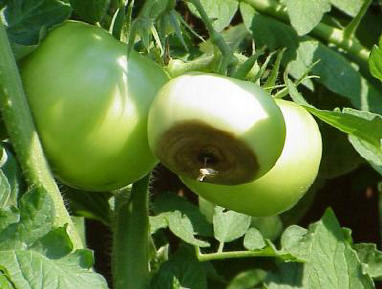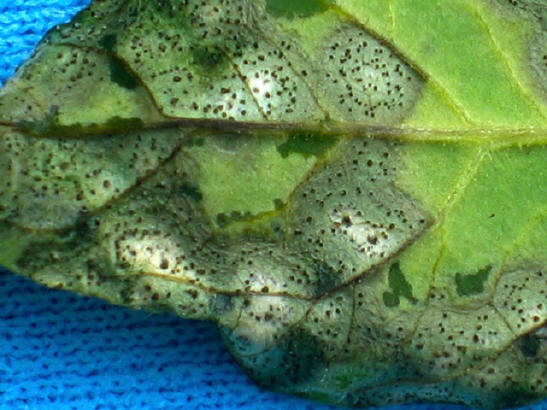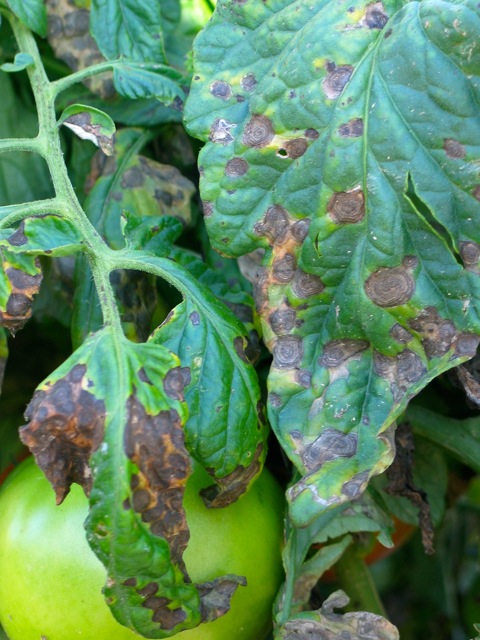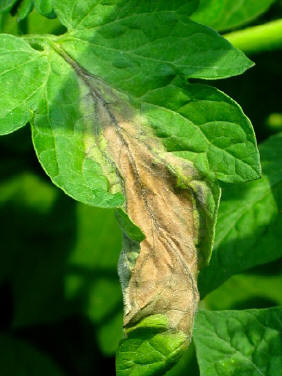 If your tomato plants are anything like mine, you are getting great tasting tomato treats. However, along with that sometimes comes what I call tomato woes. This year, for the first time, I had some bottom end or blossom end rot early in the season. This
appeared as ugly black and brown sunken-in bottoms on the fruit. This malady is due to a lack of calcium, an element so critical to fruit development. Drought, inconsistent watering, too alkaline a soil, high temperatures, or an excess of nitrogen and potassium salts (due to over fertilization) can lead to a plant’s being unable to get the calcium it needs - assuming it
already is present in your soil. Always get a soil test (kits are available at the Extension office).
If your tomato plants are anything like mine, you are getting great tasting tomato treats. However, along with that sometimes comes what I call tomato woes. This year, for the first time, I had some bottom end or blossom end rot early in the season. This
appeared as ugly black and brown sunken-in bottoms on the fruit. This malady is due to a lack of calcium, an element so critical to fruit development. Drought, inconsistent watering, too alkaline a soil, high temperatures, or an excess of nitrogen and potassium salts (due to over fertilization) can lead to a plant’s being unable to get the calcium it needs - assuming it
already is present in your soil. Always get a soil test (kits are available at the Extension office).
To prevent or remedy this woe, keep plants well mulched and evenly watered at the soil level, not on the leaves (that promotes other fungal woes). Try adding a calcium supplement (follow label directions) or place 1-2 tablespoons of hydrated lime over the root zone and water thoroughly. I even fill my freshly emptied milk jugs with water and pour that milky rinse water
over the root zone.
|

This photograph shows the effects of "blossom end rot'
|
Another woe this summer was one plant got yellow shoulder on a few fruits located along the outside perimeter of a south facing plant. The stem area on top of that fruit had hard yellow-green places that never got red. This woe can develop when prolonged hot sun strikes the fruit increasing the temperature in the top of the fruit. This in turn leads to inhibited
lycopene production causing the tops to stay hard, green or yellow. Some varieties are more prone to this problem than others.
Another yellow shoulder contributing cause has to do with the chlorophyll that gives plants their green color. Excessive heat prevents chlorophyll from breaking down. When ripening green tomatoes are in direct hot sun for hours on end, chlorophyll hangs on. That together with a lack of lycopene leads to yellow shoulder. It can be remedied or prevented by maintaining
good leaf cover over the fruit. Avoid overzealous leaf or sucker pruning since that exposes developing fruit to the sun. Grow hybrid varieties bred to avoid it (heirloom tomatoes are more prone to this woe).
Overly dry conditions caused another of my woes - skin cracks following a 2.5-inch rain. Very dry conditions alleviated by lots of rain or excessive watering can cause some varieties to crack around the top or split top towards bottom. Getting too much water too fast causes both. The tomato inside grows faster than its outside so its expanding skin cracks to relieve
the pressure. Maintain even moisture levels and mulch plants well to prevent this woe and consider crack-resistant varieties.
The last woe for this discussion is called cat facing. Not sure why a cat gets picked on for this woe since the resulting deformation does not look like a cat face to me. Anyway, it is a sign of poor pollination resulting from tomato flowers being exposed to cold night temperatures; usually below 50 degrees F. The blossom end is shrunken in, somewhat deformed, and
scabby looking, not rotted (like blossom end rot). The only remedy is to protect young flowering plants during cold snaps or set plants out later in warmer weather.
Lastly, ever wonder why some tomatoes grow 6 feet tall and others stay smaller or why you get so many tomatoes all at once? It depends upon which type of tomato you grow – determinate or indeterminate. Determinate varieties, also called "bush" tomatoes, are bred to be compact in height (approximately 4 feet) and can be grown in containers. Determinate plants stop
growing when fruit sets and ripen their entire crop at nearly the same time, usually over a two-week period, and then die. They should NOT be pruned or suckered as this severely reduces the amount of potential fruit. Examples are: Rutgers, Roma, Celebrity (called a semi-determinate by some), and Marglobe.
Indeterminate tomatoes, also called "vining" tomatoes, continue to bloom, set new fruit, and ripen mature fruit simultaneously throughout the growing season until frost. Near the end of the growing season, removing new flowers and immature fruit can help speed ripening of mature fruit. Indeterminate plants can reach heights of up to 10 feet although 6 feet is
considered the norm. As a result, these plants are not for containers since they require substantial caging or staking for support. I grow mine in large homemade wire cages and never sucker the plants. My plants easily reach over 6-7 feet and have lush growth that protects their fruit from sun-based woes and pecking birds. Grown in cages, fruit stays cleaner and no plant
tying and staking are needed. Yields are large. Building big tomato cages is a bit of an outlay initially, but well-made cages last many years. Examples are: Big Boy, Better Boy, Beef Master, most "cherry" types, Early Girl, and most heirloom varieties.
Experiment to see what type of plant you prefer to grow, and now you know what can cause tomato woes.
More Tomato Woes
This article follows my earlier one about tomato woes. It covers the types of fungal blights that are, in my opinion, the worst of the woes. A woe my tomatoes get every year at some point is Septoria leaf spot. In my garden, the disease originated from Rudbeckia coneflowers (they are prone to getting it). It spread to my tomatoes, and now resides in the soil in that
garden bed. It is very common and can occur wherever tomatoes are grown. It presents as small round dark tan to grey lesions or spots with brown margins. It usually appears on the lower leaves first. If conditions are favorable, the spots enlarge and turn infected leaves yellow then brown. Fruit usually is not infected. If caught early, lower infected leaves can be
removed to attempt to head it off. That is what I do to manage its impact. Eventually it works its way further up the plant.

This disease overwinters in soil and in tomato leaf debris left over from the following year. Residing in the soil, it is spread up from the soil by splashing when watering, especially overhead watering. Keep foliage dry by using a soaker hose or emitter or dribble system at the base of the plant. Long periods of high humidity, higher temperatures and leaf wetness are
ideal conditions for disease development and spread. Minimize chances of getting this woe by mulching around the base of the plants. Mulching reduces splashing up from soil that may contain fungal spores. Also improve air circulation around plants with increased spacing between plants. Crop rotation is useful if adequate space is available; at least two to three years are
best.
 Another fungal woe is early blight. It occurs on the foliage, stem and also fruit. It first appears as small brown to black lesions on older foliage. As the lesions get bigger, they develop concentric rings looking much like a bulls-eye. This target-like appearance
of the spots is most characteristic of this woe and distinguishes it from Septoria and Late blight. Plants can become defoliated. Fruit infected can drop with significant losses of immature fruit. Management of this woe is similar to that described above. Onset can possibly be delayed with regular fungicide sprays following appropriate label directions. Early blight also
can reside in infected potato tubers . Rotate both tomato and potato crops if infections are present in either.
Another fungal woe is early blight. It occurs on the foliage, stem and also fruit. It first appears as small brown to black lesions on older foliage. As the lesions get bigger, they develop concentric rings looking much like a bulls-eye. This target-like appearance
of the spots is most characteristic of this woe and distinguishes it from Septoria and Late blight. Plants can become defoliated. Fruit infected can drop with significant losses of immature fruit. Management of this woe is similar to that described above. Onset can possibly be delayed with regular fungicide sprays following appropriate label directions. Early blight also
can reside in infected potato tubers . Rotate both tomato and potato crops if infections are present in either.
This last fungal woe is the most damaging and it is late blight. The disease pathogen is well named, ‘Phytophthora’ meaning "plant destroyer" in Latin. It devastated tomato and potato crops in 2009. Back then I watched my tomato plants just die before my eyes. Luckily it is not seen that often.
 Late blight can affect all parts of the plant. On leaves of tomato or potato, late blight begins as pale or olive green areas that quickly enlarge to become brown or black, water-soaked, and oily like. Large, dark brown lesions develop on the stems. Impact is especially great when stems
are infected because all tissue above this point will die. If weather conditions are cool and wet, entire plants can die from late blight in as little as seven days.
Late blight can affect all parts of the plant. On leaves of tomato or potato, late blight begins as pale or olive green areas that quickly enlarge to become brown or black, water-soaked, and oily like. Large, dark brown lesions develop on the stems. Impact is especially great when stems
are infected because all tissue above this point will die. If weather conditions are cool and wet, entire plants can die from late blight in as little as seven days.
Plants showing symptoms of late blight cannot be saved and should be disposed of immediately to limit the spread to other tomato or potato plants. The best method of disposal is to pull affected plants, roots and all, and place in plastic bags. The bags should be left in the sun for a few days. Bagged plants then can be put into trash. Diseased plants or pieces of
tomato fruits or potato tubers should NOT be composted at the gardens or left in the garden.
It is important to recognize that late blight is not like other diseases. It cannot be lived with because of its potential impact. This disease can be explosive especially under favorable conditions. Without control measures, total loss of tomatoes and potatoes often occurs. Its occurrence in your garden can affect other gardens and farms due to the wind based
spreading of disease spores. Currently the late blight pathogen is only known to be able to survive on living plant tissue such as overwintered potato tubers and volunteer tomato and potato plants. If suspected symptoms of late blight are found, take a sample, well sealed in a plastic bag to the local extension office for confirmation.
Good garden hygiene is critical to keeping these fungal tomato woes at bay.
Read other articles on growing herbs or vegetables
Read other articles by Connie Holland